2021 Aprilia RS660 Review - First Ride

Putting the fun back into middleweights
I knew this day would come eventually. I didn’t expect it to take so long, but I suppose good things like the Aprilia RS660 are worth waiting for. You see, as an owner of a Suzuki SV650 that’s almost of legal drinking age (and a former Kawasaki Versys 650 owner), I have a soft spot for bikes in this middleweight category. They hit that sweet spot between power, performance, and price – there’s just enough power to keep things exciting, moderate performance to emphasize the importance of rider skill, and well…SVs are dirt cheap. After all this time, I still haven’t found a compelling reason to replace my trusty little Suzuki.
2021 Aprilia RS660
| Engine | 18.5/20 |
| Suspension/Handling | 12.0/15 |
| Transmission/Clutch | 8.5/10 |
| Brakes | 8.5/10 |
| Instruments/Controls | 4.0/5 |
| Ergonomics/Comfort | 9.0/10 |
| Appearance/Quality | 9.5/10 |
| Desirability | 9.5/10 |
| Value | 7.5/10 |
| Overall Score | 87/100 |
My whole paradigm changed just 200 yards into my first ride with the new RS660 as I thought to myself, “Oh, this bike is good.” It’s a feeling that continued through the next eight hours riding Aprilia’s hotly anticipated middleweight twin. For the first time in a long time, the thought of parting ways with my trusty SV crossed my mind.
Now, granted, Aprilia *really* wants you to know the RS660 is a streetable sportbike first and foremost, with emphasis on streetable comfort and practicality. But you don’t style a motorcycle like this, claim it has heavy influences from my other favorite Aprilia – the track-ready RSV4 1100 – and not expect people like me to salivate over the opportunity to wring its neck at the racetrack.
Everything You Want To Know About The Aprilia RS660
(Except What It’s Like To Ride)
But maybe I’m getting ahead of myself. Let’s play Aprilia’s game for a minute and talk about what the new RS660 is like on the street. As a reminder, we’ve already covered the full tech details about the Aprilia in another article. Click here to read all about it, if you haven’t already, and bring yourself up to speed. This is about what it’s like to ride (finally).
What is a Streetable Sportbike, Anyway?
In short, the RS represents the first in a line of motorcycles to be built on this platform. The engine is an all-new 659cc parallel-Twin Aprilia says takes heavy design and engineering influences from the RSV4 1100 but with half the cylinders. It’s claimed to make 100 (crankshaft) horsepower at 10,500 rpm and 49.4 lb-ft of torque at 8,500 rpm. More importantly, especially for the street environment, Aprilia designed this bike for, 80% of its torque is available as low as 4,000 rpm.
This is the first nod in the Aprilia’s favor when looking at the RS660 compared to other middleweight bikes a rider might look to jump to after getting the basics down on their first motorcycle. With a traditional 600cc supersport, which makes better numbers on paper, all that performance isn’t truly tapped into until you’re reaching stratospheric engine speeds. Not to mention those bikes put you in a committed riding position that’s best left to the track. Meanwhile, other twin-cylinder middleweights like the SV650 or Yamaha MT-07 make excellent, usable low-end torque and are fairly comfortable but sign off fairly quickly and aren’t nearly as nice to look at.
The RS660 slots nicely in-between. Sitting on it, the 403-pound RS feels light between your legs. Once you reach down to grab the bars, you’ll notice you’re not reaching super far since the bars are raised above the triple clamp. The pegs are comfortably placed and are extremely close to each other – it felt like I could almost click my heels together – thanks in part to being mounted through the (adjustable) swingarm pivot. This is a clever packaging trick, but if/when it comes time to change the pegs, you’ll be going through your dictionary of Italian curse words…
Riding It
Back to the power. No matter which of the five riding modes you select (three for street, two for track), the 660 scoots off the line with purpose, and when doddling through town, on the highway, or through tight, twisty roads, the low-end and mid-range grunt is impressive for a medium-displacement Twin, every bit on par with the Suzuki or Yamaha mentioned above, and immensely more usable (dare I say, enjoyable?) than the crop of high-strung supersports. If you’re used to bigger bikes and are coming down to the 660, then you might find yourself downshifting more often to keep the Aprilia in its sweet spot, but this is easy enough given the standard up/down quickshifter. Granted, it is a little notchy, with slightly longer ignition kill times than I’d like, but it’s far from a deal-breaker. You can also change it to reverse shift (first gear is up, the rest down) by simply flipping the shift linkage and changing the quickshifter software. No extra hardware needed.
Given enough room to stretch its legs, the RS has enough engine to leave the SV or MT behind, all while barking a beautiful sound from its standard exhaust that comes from a 270-degree parallel-Twin in full song. It really does sound like a baby RSV4! Unlike an RSV4, you’ll be well into fourth gear at 100 mph, but the bike sounds so cool, and shifts so easily, that it really isn’t a bother.
Being a streetable sportybike also means logging miles on the highway at times. This is where the RS surprised more than I expected. Once you settle in to your cruising speed you notice sixth gear is very tall and ideal for cruising. At 80 mph in sixth the engine is turning over at something around 5,000 rpm, with the instant mpg reader on the clock measuring in the high 40s or low 50s, depending on conditions. Granted, on-board mileage calculators aren’t the most accurate things in the world, but it was all I had at my disposal.
Cruising along, it was nice not being perched into an aggressive supersport position, but there is just enough forward lean to cut through the air without feeling like a sail. Despite its compact stature, if I did want to tuck down, there’s enough room to scoot back, get under the bubble, and tuck my elbows in without touching my knees. Doing so, I instantly noticed the fuel mileage calculator increase 10 whole miles per gallon. I wasn’t expecting a tuck to have that much influence. Another surprise was just how comfy the seat is. Whatever grade of foam Aprilia found to stick in the RS’s saddle must have traces of clouds and pillows mixed within it, because it is downright comfortable. Usually, on rides like this, each photo stop is a perfect opportunity to hop off and get some blood flow back to the butt. On the Aprilia, I noticed the assembled cast of yahoos rarely got off the bike whenever we stopped. There just wasn’t a need.
The inherent downside to a parallel-Twin, as opposed to a 90-degree V, is engine vibration. The RS660 does feature a single counterbalancer, but even still vibes were noticeable throughout the ride. It was far from being a dealbreaker, but they were nonetheless noticed, prompting a few journos, including Yours Truly, to activate the cruise control(!) and let the blood come back to our hands.
Flogging It
Hopefully you, like us, ride the RS660 on the highway because you’re making your way to the fun roads. This is where the 660’s personality really shines, as its loud bark bounces off the canyon walls, encouraging you to let the engine sing as long as you dare.
Eventually, you’ll have to slow down, and the Brembo master cylinder, steel-braided lines, and radial caliper combo combine wonderfully to bite down on the 320mm discs and scrub speed with power and modulation you simply don’t find with the lesser components found on other bikes in the class. There’s cornering ABS on here, too, but considering the perfect riding conditions on our ride day I couldn’t tell you how well (or bad) it works.
The joy of middleweight bikes in this class is exploiting their handling capabilities because you don’t have horsepower to rely on. Riding the RS660 in this way reveals the magic of the bike. Once you’re in the thick of the twisty stuff, the RS bends into turns easily, its 403-pound (claimed) wet weight hardly noticeable, as the bike carries its mass well.
The inverted Kayaba fork and the single shock in the rear are rather basic, with only rebound and spring preload adjustability, but that’s the norm for the class and probably the first thing anyone serious about going fast on this bike is going to change. Damping leans towards “sporty-street,” with nice compliance during regular riding and even medium-paced canyon runs.
Once the pace picks up a bit, the suspension starts to protest, compressing too quickly and getting a bit unsettled. All this is another reminder to ride the RS in typical Aprilia fashion – by carrying corner speed, flowing through turns, and letting momentum be your guide. Riding the RS with grace is rewarding. Trying to manhandle it like a bigger bike is not. A nice touch: the pockets in the fuel tank are perfectly shaped to brace your legs against while leaning over, at least if you’re under 6-foot with a 30(ish)-inch inseam.
It’s a deeply satisfying feeling when you have the RS in the right gear, flow through a set of sweepers – left, then right, then left – and exit the last corner hard on the gas, letting the engine sing while grabbing another clutchless shift around 10,000 rpm (there isn’t much left the closer you get to its 11,500 rpm redline). Apart from the awesome exhaust sound, there’s the satisfaction of being able to wind the throttle open without terrifying yourself with the subsequent uptick in speed – just one of the many reasons why this class is so appealing.
There’s an IMU-assisted adjustable traction control system here, but considering the perfect conditions of our ride day the Pirelli Diablo Rosso Corsa II rubber handled all 100 or so horses and 50 pound-feet without ever protesting, even with TC completely turned off. Were the road or weather conditions sketchy, then I’m sure these rider aids would prove their worth in a heartbeat.
So, let’s talk about the electronics a little more. Even in the Commute ride mode, the most intrusive, the ride isn’t dumbed down. Switch to Dynamic and there’s a small but noticeable difference in initial throttle application. Traction control and ABS settings are loosened up and are less intrusive, too. Switching to the third mode, Individual, is easy enough with the buttons on the switchgear, and allows you to manually adjust TC, ABS, engine braking, wheelie control, and engine mapping (aka ride mode). The last two modes: Challenge and Time Attack, are dedicated track settings, so we didn’t get the opportunity to explore what’s possible there. But we will. Personally, I’d just leave it in full-power mode with minimal interventions. At least in the dry. The power doesn’t take long to get used to and is delivered very smoothly.
Negatives
In case it wasn’t obvious by now, I’m a big fan of the RS660. It speaks to the kind of riding I enjoy a lot, and it’s damn good, too. But it’s not without fault. As mentioned before, it’s a little buzzy, and the quickshifter isn’t so smooth at lower revs. There’s a dedicated passenger seat, too, and while it’s slightly more broad and padded than the laughable plank the RSV4 calls a passenger seat, those intrepid journos who bothered to sit back there (for science) quickly hopped off and shook their heads. If two-up riding is in your future, wait for another model to pop up from this platform. The RS660 isn’t it.
Other notables: the test units we rode were pre-production units. As such there were a few errant lights flashing on the dash from time to time and a wire or two sticking out that otherwise would be tucked away. This isn’t much of concern as long as Aprilia sort out those little things on the final production line.
Maybe more annoying are the steps involved if you want to modify the peg or bar position (or, heaven forbid, you need to replace them after a crash). The bars are less annoying, as the bar itself is bolted to its mount which is integrated into the casting of the triple clamp. Theoretically, replacing a bar is as simple as unbolting the old one and replacing it with a new one. However, a major crash could potentially ruin the mount altogether, meaning an entirely new triple clamp. And because the bar mount is part of the triple, anyone with plans to track the RS and wants to lower the bar position will have a much tougher time doing so.
Speaking of tough times, because the footpegs are mounted through the swingarm pivot, that’s going to have to come out in order to replace the pegs. Ground clearance really isn’t an issue, but inevitably people are going to want to mount rearsets. Doing so is not going to be straightforward.
Competitor Comparison
So what motorcycles is the Aprilia RS660 competing against, anyway? With its 659cc Twin it’s easy to point out bikes like the Suzuki SV650, Yamaha MT-07, Kawasaki Ninja 650/Z650, and even Honda’s CBR650R. Hell, I started this review off by talking about my SV. But with the Apriila’s full fairing you could say the Suzuki, Yamaha, and Z650 are out of the picture (those are arguably more evenly matched with the upcoming Tuono 660 based on this same platform). Regardless, I’d take the RS660 over all those bikes as the performance, technology, and/or cool factor outweighs all of them.
Then there’s the price. At $11,299, the RS660 is as much as $4200 more expensive than the middleweight Twin competition. Then again, it costs more because you’re also getting more, and if track duty is why you’re eye-balling this bike over the others, then it’s a no-brainer. It’s also more than many 600cc supersports, which certainly have more performance, but I’d argue are less enjoyable to live with outside the racetrack. If you never, or rarely, plan to take the RS to the track though, suddenly motorcycles like the $13,095 Ducati Supersport enter the picture. With slightly more power, torque, and weight, the Ducati poses an interesting challenge for the Aprilia.
But if we’re looking at price and loosening our restrictions about the amount of bodywork on the bike, then we also have to include the KTM 790 Duke ($10,699) and Triumph Street Triple range (starting at $9,950), both of which cost less than the RS660. We can only assume the Tuono 660 will cost less than the RS660 and be a more appropriate rival to the KTM, Triumph, and naked middleweights, but regardless, at this price, the competition is fiercely stacked.
The Next Cult Classic?
It seems fitting to wrap this up by revisiting where we started, with my trusty SV650. Twenty years on and Suzuki is still making the bike. It’s a cult classic in a way few bikes are able to achieve. In many ways, the instant satisfaction I got from the RS660 leads me to believe that Aprilia might have another cult classic in the making. The pure joy and satisfaction from riding it in its element is hard to beat. What’s more, simply riding it *not* in its element (ie. commuting) is not so bad, either. To think that this is just the first in a long line of future models to be built on this platform is also exciting, especially if a sportybike is not your flavor.
For me, the RS brings back a lot of the emotions I had when I first laid eyes on the SV – I love the looks, and now that I’ve ridden it, I love its performance. There are definitely faster, more powerful motorcycles out there, but I’ll argue the RS660 is every bit as satisfying.
2021 Aprilia RS660
+ Highs
- Fun little engine
- In fact, fun little bike!
- Surprisingly roomy and comfortable
– Sighs
- $11,299 is pretty steep
- Engine’s a little buzzy
- Bars and pegs could be a hassle to change
In Gear
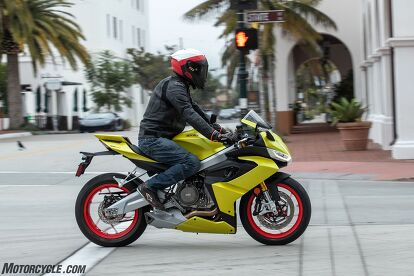
Helmet: Bell Race Star Flex DLX $670
- Leathers: Alpinestars Core Leather Jacket $495
- Airbag: Alpinestars Tech-Air 5 $700
- Gloves: Alpinestars SP-2 v2 Glove $140
Boots: Alpinestars Faster-3 Rideknit Riding Shoe $180
2021 Aprilia RS660 Specifications | |
|---|---|
| MSRP | $11,299 – $11,499 |
| Engine Type | 659cc liquid-cooled parallel-twin, DOHC, four valves per cylinder |
| Bore and Stroke | 81mm x 63.9mm |
| Compression Ratio | 13.5:1 |
| Horsepower (claimed at crankshaft) | 100 hp (73.5 kW) @ 10,500 rpm |
| Torque (claimed) | 49.4 lb-ft (67.0 Nm) @ 8,500 rpm |
| Transmission | 6-speed with Aprilia Quick Shift up-and-down system and slip/assist |
| Final Drive | Chain |
| Front Suspension | Kayaba 41 mm upside-down fork, adjustable for rebound, and spring preload. Wheel travel 4.7 inches (120mm) |
| Rear Suspension | Aluminum swingarm with asymmetrical trusses. Monoshock with adjustable rebound and spring preload. Wheel travel: 5.1 inches (130mm) |
| Front Brake | Dual radial-mounted Brembo calipers with four 32mm pistons. 320mm discs. Radial master cylinder and steel braided brake lines with Cornering ABS |
| Rear Brake | Single Brembo caliper with two 34mm pistons. 220mm disc with Cornering ABS |
| Front Tire | 120/70-17 |
| Rear Tire | 180/55-17 |
| Rake/Trail | 24.3 deg/4.1 in |
| Wheelbase | 54.4 in. |
| Seat Height | 32.3 in. |
| Curb Weight (Claimed) | 403 lbs. |
| Fuel Capacity | 3.96 gal. |
| Colors | Apex Black, Lava Red, Acid Gold |
Become a Motorcycle.com insider. Get the latest motorcycle news first by subscribing to our newsletter here.

Troy's been riding motorcycles and writing about them since 2006, getting his start at Rider Magazine. From there, he moved to Sport Rider Magazine before finally landing at Motorcycle.com in 2011. A lifelong gearhead who didn't fully immerse himself in motorcycles until his teenage years, Troy's interests have always been in technology, performance, and going fast. Naturally, racing was the perfect avenue to combine all three. Troy has been racing nearly as long as he's been riding and has competed at the AMA national level. He's also won multiple club races throughout the country, culminating in a Utah Sport Bike Association championship in 2011. He has been invited as a guest instructor for the Yamaha Champions Riding School, and when he's not out riding, he's either wrenching on bikes or watching MotoGP.
More by Troy Siahaan



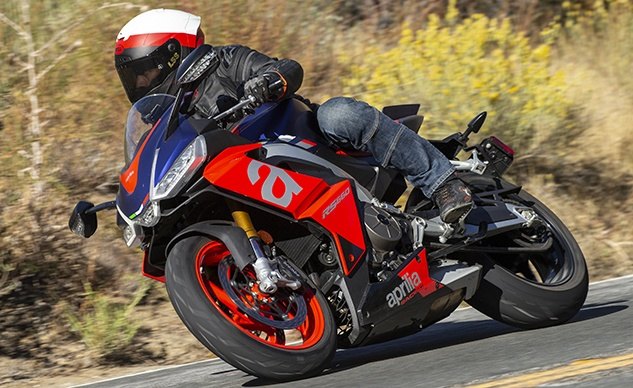







































































































































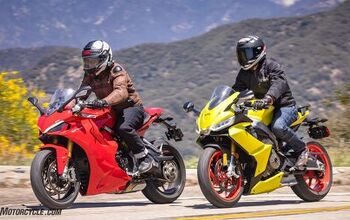
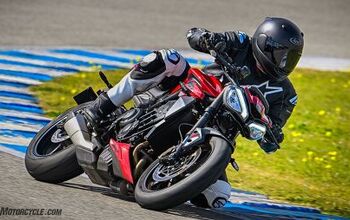
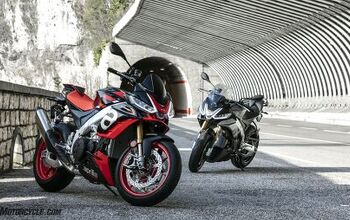











Comments
Join the conversation
She's a looker, for sure. I'd go for the yellow/gold one, I think.
This will probably sell much better in Europe where the dealer coverage is much better than in North America (does Aprilia even have any dealers in Canada?).
Though having said that, if you own a BMW, have you seen the gigantic gaps in Motorrad dealer coverage? 3 hours away is a long way when your rear drive unit or fuel pump controller dies. Ask me.
But even at home, it's nice to have a dealer within a half hour or so.
Thanks for the note on the GP shifting reconfiguration. Getting rid of the linkage and just going to a shit arm would be better. I've always wished the damn NHTSA or whatever US Government Agency required the "one down and rest up" shifting would allow an "either or" configuration.